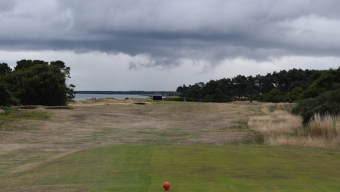INVERNESS, Scotland – So ya think this was an unusually dry summer in the USA’s Great Northwest? Well, ditto for Scotland, a country famous for high winds and pounding rain at almost any time of year.
Mother Nature threw a curve at the Scots during the summer of 2018. It was almost three months of sunshine and sunscreen instead of the usual umbrellas and parkas.
As a result, some of the oldest and finest golf courses in Scotland had to overcome some really nice weather, countering a well-deserved reputation established over the past 150 years or so.
I recently took a trip to the Home of Golf with my son and his family, including 6-year-old Andrew, who has a better golf swing than either his dad or “Papa Jim”. We played the Queen’s Course at Gleneagles, several rounds at The Nairn Golf Club, and one round at spectacular Castle Stuart Golf Links, another must-play gem if you go on a golfing trip to the Scotland Highlands.
We encountered some big-time wind (40 mph) and too many pot bunkers to count at Nairn, and a couple of punishing squalls at Castle Stuart.

Son Scott
pot-bunkered
It was everything a visiting golfer from across the pond could want.
The tees and greens at all the courses we played were green and magnificently manicured. But many fairways, especially at the 131-year-old Nairn course (pictured above), were brown and barren because most of the oldest courses in Scotland depend on rain to keep the fairways lush.
“I have been playing golf here for more than 40 years,” a life-long Aberdeen, Scotland golfer said, “and this is the first time I wore shorts from the end of May until the middle of August.”
Craig Hunter, born and raised in Scotland and currently the Head Golf Professional at Seattle’s Sand Point Country Club, has kept in touch with his homeland buddies and all agreed that this summer was one for the record books.
“I do recall one summer, when I was 7 or 8, it was so hot the blacktop on the roads melted,” Hunter said. “But I have never seen a summer like this one, where the weather was so good for such a long period of time.”
The British Open, played at Carnoustie in July, showed the result.
“On television, you could see how ‘burnt’ (the fairways) were,” Hunter said. “They were beyond ‘biscuit brown’ as the greens-keepers like to call it. The grass doesn’t die. It just goes dormant.”
But Hunter was quick to add: “The golf courses will survive. All it takes is a little rain and cooler temperatures and they will jump right back. Not to worry.”
There is less angst at the courses with an irrigation system – like Castle Stuart.

Castle Stuart GM
Stuart McColm
The picturesque gem-of-a-course that hugs the Moray Firth, is among the newest in Scotland. It opened to rave reviews in 2009, being named by Golf Magazine as the “Best New International Course” and was co-designed by Americans Mark Parsinen, the managing partner, and golf-course architect Gil Hanse.
The course, which has wide fairways, unbelievable views, and only a few bunkers (yay!!), hosted the Scottish Open in 2011, ’12, ’13 and ’16.
The 7,009-yard (from the tips), par-72 layout is on two tiers overlooking the Firth. The lower holes, No. 1, 2, 3, 10, 11, and 12 are directly on the coastline and in the windiest conditions water laps at the edge of the tee boxes and fairways. The upper tier provides stunning views that seemingly improve from one hole to the next.
The trek from the No. 12 green to the No. 13 tee box is more like a hike than a walk and you need a few moments to collect your breath before continuing the round.
There are only 36 bunkers on the entire course and none of them are around the greens.
By the end of the round, some four hours after it started, you realize what a great experience you just had on one of the top golf courses in all of Scotland, if not the world.
“We sat out to make this a challenge to test the best, and have it be playable for the rest,” general manager Stuart McColm said. “That should be the mantra for every new course that is built.”
It also helps to have an irrigation system although that is no guarantee for pristine fairways from tee to green. Perhaps the summer of 2018 was an anomaly. If not…

330-yard Par 4
9th hole at
Castle Stuart
“Water is a commodity around here and a lot of places are going to find it hard to get ahold of,” McColm said. “I was born and raised in Scotland and I can remember only one summer like this – in the mid-1970s and I was 12. We were in the (80-plus degrees) range for probably 60 consecutive days this summer and that is unheard over here. Never. Absolutely no way.
“We are using this year to learn if we can survive in the future. Let’s face it, brown is the new green.”
The fescue-only course (just like Chambers Bay) appears to have weathered the storm (so to speak) during this dreadfully dry year. Cooler, wetter weather returned in mid-August and my son and I had to use our rain-gear twice during the round.
“There are brown spots on the fairways,” McColm said before our round began. “But there is grass. It may be brown, but it’s still grass, so you will get good lies. I have not heard any complaints from the players. Not one.”
Castle Stuart has become a popular venue, especially for Americans who come to the Scottish Highlands to play a number of terrific tracks, including Royal Dornoch.
But there are so many more….





















